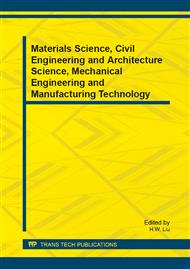[1]
Dong Yongping, Wu Xinhong, Rong Yuping, et al. Grassland remote sensing monitoring techniques [M]. Beijing: Chemical Industry Press, (2005).
Google Scholar
[2]
Cha yong, Jay Gao, Ni Shaoxiang. Most Recent Progress of International Research on Remote Sensing of Grassland Resources[J]. Progress in Geography, 2003, 22(6): 607-617.
Google Scholar
[3]
Xu Bin, Yang X iuchun, Tao Weiguo, et al. Remote sensing monitoring upon the grass production in China[J]. Acta Ecologica Sinica, 2007, 27(2): 405-413.
DOI: 10.1016/s1872-2032(07)60012-2
Google Scholar
[4]
Yang Xiuchun, Xu Bin , Zhu Xiaohua et al. Models of grass production based on remote sensing monitoring in northern agro-grazing ecotone[J]. Geographical Research, 2007, 26(2): 213-221.
Google Scholar
[5]
Wang Jing, Guo Ni, Wang Zhenguo, et al. Mointoring Model of Aboveground Biomass in Gan- nan Grassland Based on Remote Sensing[J]. Journal of Arid Meteorology, 2010, 28(2): 128-133.
Google Scholar
[6]
Xiong Kangning, Chen Yongbi, Chen Hu, et al. Touch graphite and turn it into diamond-the ecological techniques and models of controlling of Karst rocky desertification in Guizhou Province[M]. Guiyang: Guizhou Science&Technology Publishing House, (2011).
DOI: 10.17520/biods.2019351
Google Scholar
[7]
Zhao Yingshi. Principles and methods of Remote Sensing Applications Analysis[M]. Beijing: Science Press, (2003).
Google Scholar
[8]
Asner G, Lobell D. A biogeophysical approach for automated SWIR unmixing of soils and vegetation[J]. Remote Sensing of Environment, 2000, 74(1): 99-112.
DOI: 10.1016/s0034-4257(00)00126-7
Google Scholar
[9]
Gilabert M A. An Atmospheric Correction Method for the Automatic Retrieval of Surface Reflectance from TM Images [J]. Int. J. Remote Sensing, 1994, 15(10): 2065-(2086).
DOI: 10.1080/01431169408954228
Google Scholar
[10]
Li Xiaosong, Li Zengyuan, Wu Bo, et al. Retrieval of the Coverage of Artemisia ordosica Community in MuUs Sandland Based on Spectral Mixture Analysis(SMA)[J]. Journal of Remote Sensing, 2007, 11(6): 923-930.
Google Scholar
[11]
Li Su, Li Wenzheng, Zhou Jianjun, et al. Hyperspectral Image Fusion by an Enhanced Gram Schmidt Spectral Transformation [J]. Geography and Geo-Information Science, 2007, 23(5): 35-38.
Google Scholar
[12]
Liang Tiagang, Cui Xia, Feng Qisheng, et al. Remotely sensed dynamics monitoring of grassland aboveground biomass and carrying capacity during 2001- 2008 in Gannan pastoral area[J]. Acta Prataculturae Sinica, 2009, 18(6): 12-22.
Google Scholar


